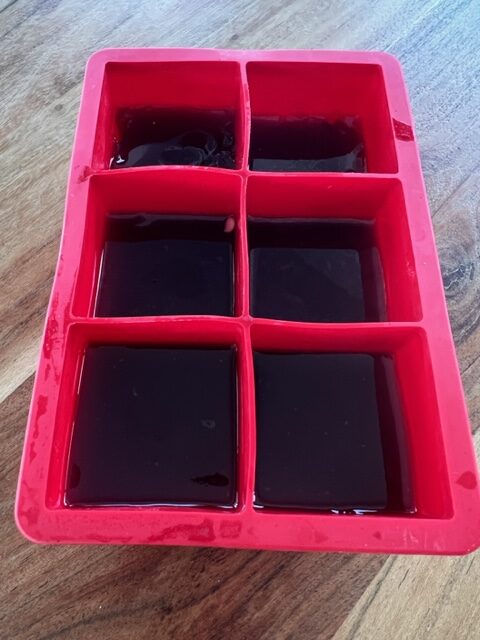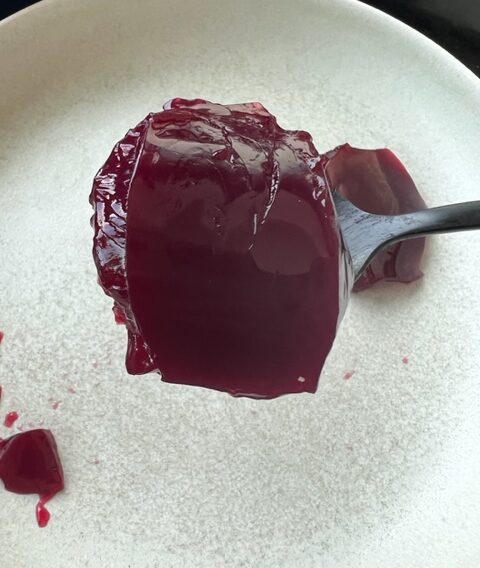You may know that gelatine (and collagen) are good for repairing a permeable gut lining (aka leaky gut). However, you can increase the chances of healing and sealing the gut by supporting a keystone bacterial strain called Akkermansia.
Akkermansia has a symbiotic relationship with the mucosal integrity of the gut lining. It both supports the mucosal membrane and relies on it. It munches old mucosal cells from the gut lining to encourage the turnover over new mucus cell production. The gut lining produces new cells every three days if the conditions are right. Akkermansia is an integral part of that process.
Akkermansia also feeds other bacterial strains in the gut. So the health and level of inflammation in the large intestine is influenced by the levels of Akkermansia.
Akkermansia is unlike other beneficial bacteria that feed on prebiotic plant fibres. Akkermansia is unusual in many ways and its preferred food source, other than the mucosal lining of the gut, is certain red skinned fruits.
I created this Akkermansia jello recipe to support both the gut lining with gelatine and Akkermansia with its preferred food source. I love using food as medicine in addition to any healing protocol, that’s why I wrote a cookbook of gut-focused recipes, designed to support the biome and lower inflammation. You can download it here.
If you’re curious about your levels of Akkermansia, it’s one to the bacteria strains measured on the GI Map stool test. If it’s low or under the detectable limit, raising Akkermansia levels will improve your chances of mending a leaky and inflamed gut lining.
In my health coaching practice, I don’t just address leaky gut with remedies such as the jello recipe below, along with probiotics and a glutamine-based repair powder. I also identify the root cause so we can reverse it.
The inflammation that causes leaky gut is often due to pathogenic overgrowth, medications (NSAIDs and other pain meds), food sensitivities and can be intensified by stress. I use the GI Map to identify the exact root cause so it can be properly addressed.
Many people make the mistake of addressing leaky gut before addressing its root cause. Addressing a permeable gut lining is typically the last step of any protocol. Once the protocol has been completed, it’s time for the gut repair phase.
But because it’s food, you can also enjoy this jello recipe during a healing protocol to support Akkermansia.
Why I choose these ingredients
Akkermansia has been shown in studies to feed on certain red skinned fruits. Cranberries, pomegranates, red dragon fruit and red grapes are examples. So are red skinned apples. Other red skinned berries like raspberries or strawberries do NOT feed Akkermansia.
Gelatin contains glycine, which is a key ingredient in repairing the gut lining by strengthening and protecting the mucous membrane layer.
I combined these leaky-gut healing ingredients to support each other symbiotically. The support comes from feeding both Akkermansia and repairing the mucosa simultaneously.
Its benefits yummy, easy to make and requires 4 to 5 ingredients.
A few notes about ingredients
I recommend using good quality gelatine from clean animal sources. I like this one.
I also recommend this dragon fruit powder to mix into the jello.
And always use unsweetened cranberry juice.
I made this with pomegranate juice, unsweetened cranberry and dragon fruit powder only. It tasted a bit tart, which was ok for me. If you want it sweeter you can add some red skinned grape juice to taste. Increase the gelatine recipe by 1/4 teaspoon for every 2 ounces of liquid added to the 2 cup recipe below.

Akkermansia jello recipe
2 cups of pomegranate juice
2 cups of unsweetened cranberry juice
3 tablespoons of pink dragon fruit powder
1.5 Tablespoons of gelatine. Use 1 Tablespoon if you like it less firm
Optional: 1/4 cup to 1/2 cup of grape juice to taste. Add 1/2 teaspoon of gelatine for every half cup of liquid added.
How to
Pour the juices and the powder in a pot and mix well with a spoon or hand blender.
Sprinkle with gelatine and let sit for 10 minutes to bloom.
After the jello has rested for 10 minutes gently heat it on low medium heat, stirring while you do until it is hot and the gelatine is melted and incorporated. Do not boil.
Let cool and transfer to large silicon ice cube molds or whatever container you want to use for it to set. I like the ice cube molds because it makes individual servings to consume daily.
It takes 5 to 8 hours for the jello to set.
This recipe is very forgiving. If the jello does not set to your preferred texture, you can throw it back in a pot on the stove and heat until it liquifies, then refrigerate again.
Enjoy this wiggly treat that will helps you nurse your gut and biome back to health.


